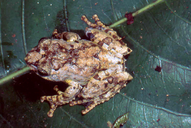|
Description
M 35-43 mm. Tibiotarsal articulation reaches the eye or between eye and nostril. Hand with a trace of webbing, foot webbing 1(0-1), 2i(0.75-1.5), 2e(0-1), 3i(1-2), 3e(0-1), 4i/e(1), 5(0). Males with nuptial pads. Dorsal skin with distinct tubercles and ridges and laterally with dermal fringes. Colour cream with a large dark brown marking. Distinct changes from light day colour to darker night colour.
Similar species: The lateral fringes on the body are unique, and the species could only be mistaken for a Spinomantis.
Tadpoles that have tentatively assigned to this species (invariably present at all the localities where the adults were found, and also in the same microhabitat frequented by adults in reproduction)have a colour grey to black with a yellow or golden band at midbody and a yellow or golden tip of the
snout. The contrasting colour of the tadpoles may be aposematic, but there are no observations to support this speculation. At midlength of the tail, the height is about ¼ of the tail length and the height of the musculature represents 1/3 of the tail height. In the anterior part of the tail
the musculature is thickened. The body is slightly flattened dorsoventrally. The spiracular opening is situated on the left side and pointed upwards. The tooth formula is 1/5+5//1+1/2 or 1/5+5//3 for the tadpole stages 26-32 and 1/4+4//1+1/2 or 1/4+4//3.
Distribution and Habitat
Country distribution from AmphibiaWeb's database: Madagascar
An’Ala, Mananara, Masoala, Tsararano, Vevembe. It is observed in the range 50-900m asl in swamps of primary and secondary rainforest (Naussbaum et al. 2008).
Life History, Abundance, Activity, and Special Behaviors
Boophis lichenoides is a nocturnal frog normally which rests motionless
on light coloured or lichen-covered tree bark during the day. Due to its dorsal colouration and its skin fringes on its arms, legs and lower lip, the frog's outline disappears nearly totally. Little is known about its reproductive behaviour. In the paper with the original description the authors mention the observation of two egg clutches, possibly of this species, collected at
Vevembe. The clutches were a loose mass of small eggs (1-1.5 mm in diameter) in the leaf litter and debris in the bottom of the pool.
Calls: A series of irregular croaks emitted with rather low intensity. Males call at night from low perches (0.5-1 m) around small pools in rainforest where the tadpoles develop.
It breeds in streams. The tadpoles are laid on the bottom in stagnant or slowly running waterpools in pristine forest or from a temporary pool on the floodplain of a swamp, which had abundant decaying vegetation on the bottom (Nussbaum et al. 2008)
Trends and Threats
Least concern. It occurs in the several protected areas (Nussbaum et al. 2008).
Relation to Humans
The species is not captured for alimentation, and as often happens for “uninteresting” species from the forest, it is almost unknown to people inhabiting villages.
Possible reasons for amphibian decline General habitat alteration and loss
Habitat modification from deforestation, or logging related activities
Intensified agriculture or grazing
Subtle changes to necessary specialized habitat
Habitat fragmentation
Comments
Taken with permission from Glaw and Vences (2007).
References
Glaw, F. and Vences, M. (1994). Amphibians and Reptiles of Madagascar. M. Vences and F. Glaw Verlags GbR., Köln.
Glaw, F., and Vences, M. (2007). Field Guide to the Amphibians and Reptiles of Madagascar. Third Edition. Vences and Glaw Verlag, Köln.
Nussbaum, R., Andreone, F., and Cadle, J. (2008). Boophis lichenoides. In: IUCN 2008. 2008 IUCN Red List of Threatened Species. www.iucnredlist.org. Downloaded on 07 April 2009.
Originally submitted by: Franco Andreone (first posted 2002-12-28)
Edited by: Henry Zhu (2009-05-05)Species Account Citation: AmphibiaWeb 2009 Boophis lichenoides: Liken treefrog <https://amphibiaweb.org/species/5420> University of California, Berkeley, CA, USA. Accessed Jun 14, 2025.
Feedback or comments about this page.
Citation: AmphibiaWeb. 2025. <https://amphibiaweb.org> University of California, Berkeley, CA, USA. Accessed 14 Jun 2025.
AmphibiaWeb's policy on data use.
| 